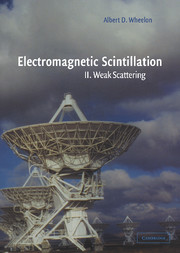Book contents
- Frontmatter
- Contents
- Preface
- 1 Introduction
- 2 The Rytov Approximation
- 3 Amplitude Variance
- 4 Spatial Covariance
- 5 The Power Spectrum and Autocorrelation
- 6 Frequency Correlations
- 7 Phase Fluctuations
- 8 Double Scattering
- 9 Field-strength Moments
- 10 Amplitude Distributions
- 11 Changes in Polarization
- 12 The Validity of the Rytov Approximation
- Appendix A Glossary of Symbols
- Appendix B Integrals of Elementary Functions
- Appendix C Integrals of Gaussian Functions
- Appendix D Bessel Functions
- Appendix E Probability Distributions
- Appendix F Delta Functions
- Appendix G Kummer Functions
- Appendix H Hypergeometric Functions
- Appendix I Aperture Averaging
- Appendix J Vector Relations
- Appendix K The Gamma Function
- Appendix L Green's Function
- Appendix M The Method of Cumulant Analysis
- Appendix N Diffraction Integrals
- Appendix O Feynman Formulas
- Author Index
- Subject Index
Preface
Published online by Cambridge University Press: 15 December 2009
- Frontmatter
- Contents
- Preface
- 1 Introduction
- 2 The Rytov Approximation
- 3 Amplitude Variance
- 4 Spatial Covariance
- 5 The Power Spectrum and Autocorrelation
- 6 Frequency Correlations
- 7 Phase Fluctuations
- 8 Double Scattering
- 9 Field-strength Moments
- 10 Amplitude Distributions
- 11 Changes in Polarization
- 12 The Validity of the Rytov Approximation
- Appendix A Glossary of Symbols
- Appendix B Integrals of Elementary Functions
- Appendix C Integrals of Gaussian Functions
- Appendix D Bessel Functions
- Appendix E Probability Distributions
- Appendix F Delta Functions
- Appendix G Kummer Functions
- Appendix H Hypergeometric Functions
- Appendix I Aperture Averaging
- Appendix J Vector Relations
- Appendix K The Gamma Function
- Appendix L Green's Function
- Appendix M The Method of Cumulant Analysis
- Appendix N Diffraction Integrals
- Appendix O Feynman Formulas
- Author Index
- Subject Index
Summary
History
Quivering of stellar images can be observed with the naked eye and was noted by ancient peoples. Aristotle tried but failed to explain it. A related phenomenon noted by early civilizations was the appearance of shadow bands on white walls just before solar eclipses. When telescopes were introduced, scintillation was observed for stars but not for large planets. Newton correctly identified these effects with atmospheric phenomena and recommended that observatories be located on the highest mountains practicable. Despite these occasional observations, the problem did not receive serious attention until modern times.
How it Began
Electromagnetic scintillation emerged as an important branch of physics following the Second World War. This interest developed primarily in response to the needs of astronomy, communication systems, military applications and atmospheric forecasting. The last fifty years have witnessed a growing, widespread interest in this field, with considerable resources being made available for measurement programs and theoretical research.
Radio signals coming from distant galaxies were detected as this era began, thereby creating the new field of radio astronomy. Microwave receivers developed by the military radar program were used with large apertures to detect these faint signals. Their amplitude varied randomly with time and it was initially suggested that the galactic sources themselves might be changing. Comparison of signals measured at widely separated receivers showed that the scintillation was uncorrelated, indicating that the random modulation was imposed by ionized layers high in the earth's atmosphere.
Information
- Type
- Chapter
- Information
- Electromagnetic Scintillation , pp. xiii - xxPublisher: Cambridge University PressPrint publication year: 2003
